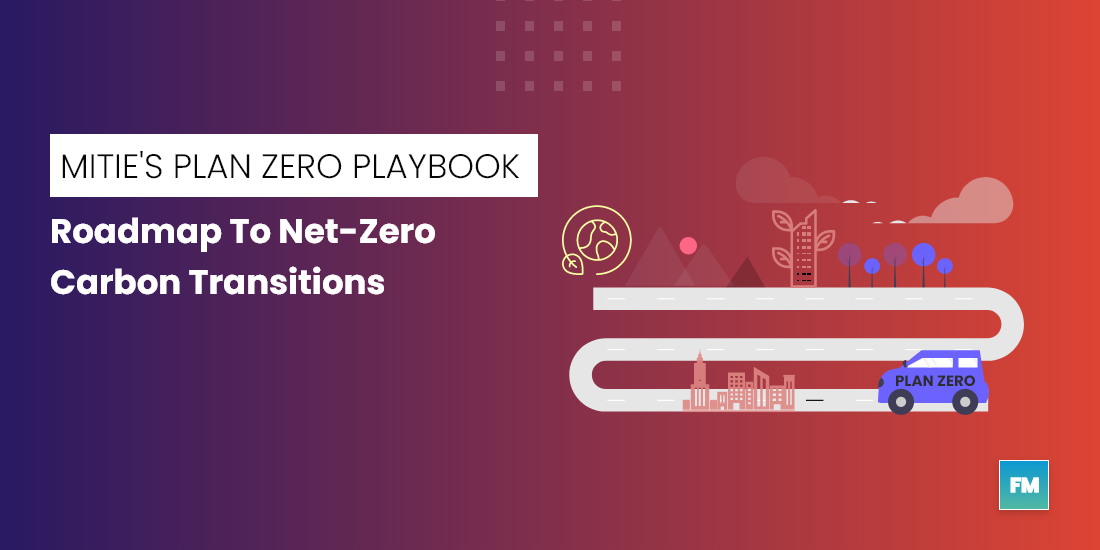If you are a regular reader of Facility management times then you would understand how much we love to talk about net-zero Initiatives. Our affection for the climate-conscious initiatives has led us to explore various aspects of net zero for the FM community.
In our previous articles, we have highlighted the relationship between analytics applications, strong leadership, and investor’s perspective to look at the net-zero buildings. We have always emphasized the planning part of the initiative where all the critical elements of target setting come into the picture. To our surprise, we recently stumbled upon a detailed handbook on plan zero initiative by Mitie that covers all the aspects from assessment to execution of a net-zero target.
And we couldn’t wait to share our observations with our readers. (please note that we are highlighting our takeaways that are related to building infrastructure)
Mitie is one of the oldest and largest FM firms based out of the UK, they have been a market leader in setting up and managing sustainability initiatives for their private and public sector clients. Plan zero initiative is a suite of sustainable facility management solutions and processes, to kickstart the net-zero carbon journey. Interestingly, It is a combination of theorized practices and the implemented solution by the Mitie on their own campuses and for their clients.
Plan zero provides a comprehensive structure to a net-zero strategy for the entire value chain of the organization. It is flexible enough to address different organizational structures and rigid enough to include all the key processes.
The Plan is divided into 3 focus areas that are responsible for maximum carbon reductions.
- Infrastructure:
Buildings, manufacturing units, and other occupied spaces of the organization. Starting from building designing, material usage and operational parameters come under the infrastructure component.
- Resources:
Water, energy, and other resource consumption, conservation, and management strategies come under the resources part.
- Emission:
Carbon emission from the logistics, manufacturing units that can be controlled come under the emission component.
The plan zero strategy looks into the carbon control from these 3 areas and devises a 5 stage plan of assessment, baseline & target setting, compliance, development, and implementation. Let’s dissect each stage and find out action items and deliverables.
Need a snapshot of the entire plan zero initiative?
check out this infographic
- Assessment:
It is about finding the common ground before starting any initiative. The team should be clear about what they want to drive from the initiations. Although it may seem difficult to comprehend the entire scope of the projects in the beginning, the team should have basic hypotheses charted out with them on what the outcomes would look like to see.
Team: For an organization, assessment is all about identifying key stakeholders to manage and lead the projects. Ideally, the team should include CXOs (sustainability head) and a good mix of people from operations, energy, procurement, and important innovation dept.
Data availability: Map down the credible data sources to gather assets (BMS, BIM), workplace (CAFM, CMMS), and emission-related data (Scope 1, 2, 3 emissions). Based on that team can segmentize ideal locations, preparedness, and gap analysis.
- Baseline & Target setting:
Comparing building’s performance against other buildings. It could be among the same organization or from the outside of the organization. There are many open-source Building benchmarking mechanisms available that can let you compare the building’s performance on resources and occupancy. It helps in creating a frame of reference to look at base targets and design comprehensive strategies to meet them.
Once the organization has a clear idea of where does their building portfolio stands against others it can set/ redefine ambitions and sustainable reduction targets. Those could be organization-specific or Science-Based targets.
- Compliance & Certification:
Every organization should comply with local (city, country-level) mandatory reporting requirements encompassing infrastructure, resources, and emissions. It is advisable to keep track of maintenance regimes and ensure appropriate energy and emissions certifications are completed on time.
Previously we have covered some of the country-level compliance & regulations plans for example. Singapore has the 80-80-80 Singapore green building master plan (SGBMP) plan, the UK has its own performance-based policy.
Mitie provides its proprietary Carbon and Energy Management System (CEMS) to assist organizations to understand various carbon-producing aspects of their operations and their associated bearing on mandatory and recommended reporting and certification.
- Development:
Create a practical plan that includes resource reduction measures, technology adoption roadmap, and scaling mechanism across the entire supply chain. Mitie suggests an implementation plan that can address each of the three Focus Areas (Infrastructure, Resources, and Emissions), and specify the associated savings, emissions reductions, and any related Capital Expenditure (CapEx).
List down all the resource reduction methods, technology implementation timeline, expected results, and next steps. Mitie has formulated a program that ensures organizations can achieve a zero-carbon future without the downsides associated with Capital Expenditure, but with all the upside of increased efficiency and offset savings. Based on the initial assessment mitie team provides a detailed report with optimization and asset replacement and upgrade recommendations
- Execution:
Final executions of those reduction measures and project performance monitoring will be the last stage of the plan zero strategies. Implementing performance-based technologies that can track the carbon consumption from infrastructure, resources, and emission segments of the organization.
Plan zero is a cyclic process which means there is always a scope of reassessing the plan according to changing times and requirements and redefining the technology procurement according to the client’s expectation.
Throughout the report, mitie has provided some excellent case studies that helped clients to navigate through that particular stage and improve their resource consumption strategy.
We sincerely hope that by now, you have got a brief idea about the plan zero initiative and a basic understanding of how to start your sustainable journey. If you have already started working on some of these sustainable building management initiatives mentioned here then share your experience with us here.

Leave a Reply